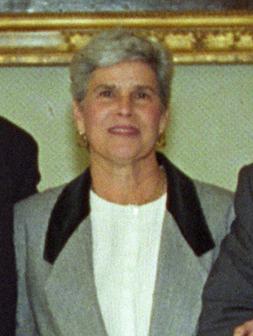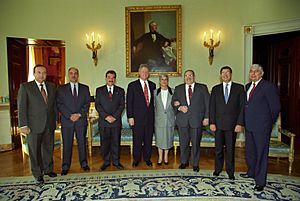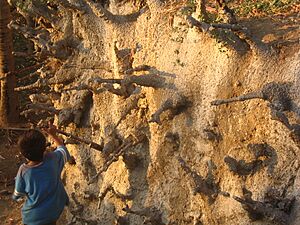Violeta Chamorro facts for kids
Quick facts for kids
Violeta Chamorro
|
|
|---|---|

Chamorro in 1993
|
|
| President of Nicaragua | |
| In office 25 April 1990 – 10 January 1997 |
|
| Vice President |
|
| Preceded by | Daniel Ortega |
| Succeeded by | Arnoldo Alemán |
| Member of the Junta of National Reconstruction | |
| In office 17 July 1979 – 19 April 1980 |
|
| Personal details | |
| Born |
Violeta Barrios Torres
18 October 1929 Rivas, Nicaragua |
| Died | 14 June 2025 (aged 95) San José, Costa Rica |
| Political party | Democratic Union of Liberation |
| Other political affiliations |
National Opposition Union |
| Spouse |
Pedro Joaquín Chamorro Cardenal
(m. 1950; died 1978) |
| Children |
|
Violeta Barrios Torres de Chamorro (born October 18, 1929 – died June 14, 2025) was a famous Nicaraguan politician. She made history as the first female president of Nicaragua, serving from 1990 to 1997. Before becoming president, she was part of the Junta of National Reconstruction, a temporary government, from 1979 to 1980.
Violeta Chamorro's husband, Pedro Joaquín Chamorro Cardenal, was a journalist. He ran his family's newspaper, La Prensa. Because he often spoke out against the government, he was jailed or sent away from the country. Violeta supported him, sometimes traveling to be with him or visiting him in prison. After he was sadly killed in 1978, Violeta took over the newspaper. His death became a strong symbol for those who opposed the government.
At first, Violeta supported the Sandinistas when they won against the old government led by Anastasio Somoza Debayle. She joined their new government, the Junta of National Reconstruction. But when the Sandinistas started to make big changes and work with the Soviet Union, Violeta resigned on April 19, 1980. She went back to leading La Prensa.
Under her leadership, La Prensa kept criticizing the government. It did this even when the government threatened to close it down. When President Daniel Ortega announced elections for 1990, Violeta Chamorro was chosen to run for a group called the National Opposition Union (UNO). This group was made of 14 different political parties. Their main goal was to end the civil war in Nicaragua. Even though polls predicted Ortega would win, Chamorro won the election on February 25, 1990. Her victory helped bring peace and end the civil war. She was the first woman to be elected as a head of state in the Americas.
Chamorro became president on April 25, 1990. Her six years in office were tough, with economic problems and social unrest. However, she managed to work with different groups, keep the government stable, and fix the country's money problems. She also ended the very high inflation that had hurt Nicaragua for years.
After leaving office on January 10, 1997, Violeta Chamorro worked on international peace projects. She retired from public life later due to poor health. She passed away on June 14, 2025.
Contents
Early Life and Family
Violeta Barrios Torres was born on October 18, 1929, in Rivas, a city near the border with Costa Rica. Her parents were Carlos José Barrios Sacasa and Amalia Torres Hurtado. Her family was wealthy and owned large farms and cattle.
She went to primary school in Rivas and Granada, Nicaragua. For high school, she studied in Managua before going to American boarding schools. Her parents wanted her to learn English well. She attended schools in San Antonio, Texas, and Virginia. In June 1947, she returned to Nicaragua when her father became very ill. She did not graduate from her American school.
Personal Life
Violeta met Pedro Joaquín Chamorro Cardenal in 1949, and they married in December 1950. They had five children together. In 1952, Pedro Joaquín took over his family's newspaper, La Prensa. He used the paper to speak out against the government of Anastasio Somoza. Because of this, he was often jailed or sent away from the country. Violeta would join him when he was exiled or visit him in jail. She earned money from a property her mother gave her, which helped support their family. When her husband was killed on January 10, 1978, she took charge of the newspaper.
Violeta's family had different political views. Two of her children, Pedro and Cristiana, worked at La Prensa. Pedro later left Nicaragua to join the Contras, a group fighting the Sandinistas. Her other children, Claudia and Carlos, supported the Sandinistas. Claudia became an ambassador, and Carlos edited the Sandinista newspaper Barricada. Despite these differences, Violeta encouraged family dinners where politics were set aside for harmony.
Sandinista Revolution and Government Role
The killing of Violeta's husband helped start the Sandinista Revolution. His image became a symbol for their cause. When Daniel Ortega and the Sandinista fighters entered Managua in July 1979, Violeta was with them. A new government was formed to replace the Somoza regime. Violeta represented the Democratic Union of Liberation (UDEL) in the first Junta of National Reconstruction. This group also included Daniel Ortega and other leaders. They promised fair elections, free businesses, and a free press.
After the civil war, Nicaragua was in a very difficult state. The Sandinistas began to take control of TV and radio stations and censor newspapers. They also made agreements with the Soviet Union. Because of these changes, Violeta Chamorro resigned from the Junta on April 19, 1980. She felt the Sandinistas were not keeping their promises for a democracy. She returned to La Prensa, making it a strong voice for free speech and opposition. Her newspaper often faced shutdowns and threats. In 1986, President Ortega even threatened her with prison. However, she won an award from Harvard University for her dedication to a free press despite government pressure.
The 1990 Election
Starting in 1987, 14 political parties worked together to try and defeat the Sandinistas in the next election. By 1989, leaders from Central America convinced Ortega to hold elections. He agreed to free elections and allowed international groups to watch the process. The opposition group, now called the National Opposition Union (UNO), chose Violeta Chamorro as their candidate for president.
Her main promises were to end the civil war and stop mandatory military service. She also wanted to forgive political prisoners and use free-market economic policies. Her campaign highlighted her simple nature, her faith, and her image as a caring "queen-mother" and the wife of a hero.
Most news outlets thought Chamorro could not win. They said she was too rich and lacked experience. There were rumors she received money from the United States, but she had always spoken out against U.S. involvement in Nicaragua. Her humble background and strong faith actually helped her connect with many people. Her biggest appeal was her promise of peace to a country tired of war. Ortega spent a lot of money on his campaign and seemed very confident he would win.
The United States government also believed Chamorro needed help to win. They provided aid for election monitoring and voter turnout, but not direct support to her campaign. This aid faced many delays.
The election was held during a civil war, so it was important for it to be fair. Many international observers, including former U.S. President Jimmy Carter, watched the process. On February 25, 1990, Chamorro won the election with 54.7% of the votes. This was a surprise to many. Ortega accepted his defeat, and the power was handed over peacefully.
Chamorro's win is thought to have happened because Nicaraguans were tired of Ortega's government. The economy was very bad, and people feared the war would continue. Many voted for Chamorro because she promised peace and an end to economic hardship.
Presidency (1990–1997)
On April 25, 1990, Violeta Chamorro was sworn in as president. This was a historic moment, as it was the first time in over 50 years that a government in Nicaragua had peacefully given up power to the opposition after a free election.
Experts who studied the election believed people voted for Chamorro to end the war. They wanted to remove the threat of more conflict. Even Sandinista analysts agreed that they had lost touch with what the people truly wanted. Voters were not just thinking about the bad economy; they wanted peace and freedom.
Peace Reforms
Chamorro's efforts to bring peace are one of her most important achievements. She officially declared an end to the war. She kept the peace by making the military smaller and less powerful. She ended the national draft, meaning young people no longer had to join the army. She also disbanded the Contras, the U.S.-backed fighters, which left the Sandinistas with no one to fight. This helped create a very effective peace.
Chamorro also offered forgiveness for political crimes. This helped make the change in power smoother. To get weapons out of people's hands, she started a program to buy them back. All the collected weapons were covered in concrete at the Plaza de la Paz (Peace Square) in Managua. This park was built to symbolize "Never Again," meaning the country hoped to avoid such violence in the future.
However, ending the war meant about 70,000 military people lost their jobs. Many did not receive the money or land they were promised. This led to protests from former soldiers. To help, Chamorro allowed some former Contra fighters to join the rural police. She also kept the Sandinistas' land reform program and expanded it.
Chamorro had to balance many different groups. Her vice president wanted to exclude the Sandinistas, but Chamorro kept Daniel Ortega's brother, Humberto Ortega, as a military leader. She became the Defense Minister and named Humberto Ortega as her second-in-command. Some people criticized her for this, but it showed she was willing to compromise for the good of the country and promote reconciliation. She also appointed three Sandinista members to her cabinet.
Relations with the United States
When Chamorro was elected, U.S. President George H. W. Bush ended the economic restrictions that had been placed on Nicaragua during Sandinista rule. He also promised economic aid. The United States helped Nicaragua pay off its old debts to international banks. Chamorro's team hoped for a lot of aid to rebuild the country, but the U.S. gave less than expected. This aid was not enough to make big improvements, and new loans created even more debt.
During Chamorro's presidency, the U.S. became less interested in Nicaragua. When Chamorro visited the U.S. in 1991 to ask for more aid, few members of Congress came to listen. Because the Sandinistas were no longer a threat and peace was being made, the U.S. focused on other global issues. To improve relations, Chamorro's government dropped a lawsuit against the U.S. in the International Court of Justice.
In 1992, a U.S. Senator named Jesse Helms tried to stop financial aid to Nicaragua. He claimed that Sandinistas still controlled much of the Nicaraguan government. He demanded that Chamorro replace former Sandinista officers and judges and return property taken from U.S. citizens. Chamorro's government denied these claims but tried to meet his demands. Helms succeeded in cutting off $104 million in promised aid.
Economic Stability

Chamorro took over an economy that was ruined by civil war and very high inflation, which had reached over 13,000% at one point. Her government immediately worked to stop inflation. They tried to bring Nicaragua back into the world market and increase foreign investment. They also began selling off state-owned companies.
The government introduced a new currency, the córdoba oro, which was meant to be equal to the U.S. dollar. However, people did not trust the new currency. The government also cut spending by reducing subsidies on basic goods. This caused problems for working-class people, who faced rising prices and job losses.
In the early months of her presidency, social programs were cut, including free bus tokens for students, pensions for the elderly, and child care services. By 1991, these cuts led to big strikes. Chamorro agreed to let workers own 25% of the privatized state companies, even though some people disagreed.
Despite these challenges, inflation was reduced by renegotiating the country's debt. The U.S. helped Nicaragua pay off old debts to international organizations. These steps helped end hyperinflation and reopen financial markets. However, the country still faced high unemployment and poverty. Public spending on health and child development also decreased.
Even with these difficulties, some positive changes occurred. Infant mortality rates decreased, and life expectancy increased during Chamorro's time in office. Rural poverty also saw a decline.
Constitutional Challenges
Besides economic issues, a big challenge in 1995 was a disagreement over the country's Constitution. The original constitution, written by the Sandinistas, gave a lot of power to the president. In 1993, the legislature began to change the constitution to balance power more evenly. The changes aimed to reduce the president's power, give the legislature more control over taxes, and prevent presidents from being re-elected immediately or having close family members succeed them.
Chamorro refused to officially publish these changes, saying the legislature had gone too far. In response, the legislature published them anyway, creating a situation where there were two versions of the constitution. The Supreme Court could not decide what to do. As international investors worried about the instability, a Roman Catholic cardinal stepped in to help. Chamorro agreed to publish the new constitution, and the legislature agreed to let the president continue negotiating foreign aid. One important change, which banned nepotism (giving jobs to family members), was accepted by Chamorro. Both sides felt they had won, and power became more shared between the president and the legislature.
Women's Role in Society
During Chamorro's time as president, few major advances were made in women's rights. Chamorro herself was not a feminist in the traditional sense. Cuts in public services, like child care, made life harder for low-income women. However, Chamorro did support women's right to own property, seeing it as a way to protect them if they became divorced or widowed. Her government did not actively encourage women to participate in political life or appoint many women to high government positions.
Chamorro's economic policies did lead to more women working outside the home. Women's participation in the workforce increased significantly, becoming one of the highest rates in Central America. However, wages for women did not increase much during this time.
After the Presidency
Violeta Chamorro did not run for president again in the 1996 Nicaraguan general election because the Constitution did not allow presidents to be re-elected right away. Arnoldo Alemán won the election and took over as president on January 10, 1997.
After leaving office, Chamorro retired from politics. In July 1997, she started the Violeta Barrios de Chamorro Foundation. This foundation worked on projects to strengthen peace. However, it stopped operating in Nicaragua in 2021 due to pressure from Daniel Ortega's government, who returned to power in 2007. Chamorro also joined international groups that worked for cooperation and peace in the Americas.
In October 2023, she moved from her family home in Managua, Nicaragua, to Costa Rica.
Illness and Death
Violeta Chamorro had health problems, including osteoporosis, which caused her to use crutches during her presidential campaign. She later developed a brain tumor, which led her to retire from public life.
Violeta Chamorro passed away in San José, Costa Rica, on June 14, 2025, at the age of 95. Her family announced that she would be buried in Costa Rica, saying she would remain there "until Nicaragua is once again a republic." Her funeral was held on June 16 in San José, and she was buried the next day in her uncle's tomb in San José's General Cemetery.
Awards and Recognition
- Isaiah Thomas Award in Publishing from the Rochester Institute of Technology.
- 1986 – Louis M. Lyons Award for Conscience and Integrity in Journalism.
- 1991 – Democracy Award from the National Endowment for Democracy.
- 1997 – Path to Peace Award from the Path to Peace Foundation.
- 2001 – Award for Leadership in Global Trade.
See also
 In Spanish: Violeta Chamorro para niños
In Spanish: Violeta Chamorro para niños




